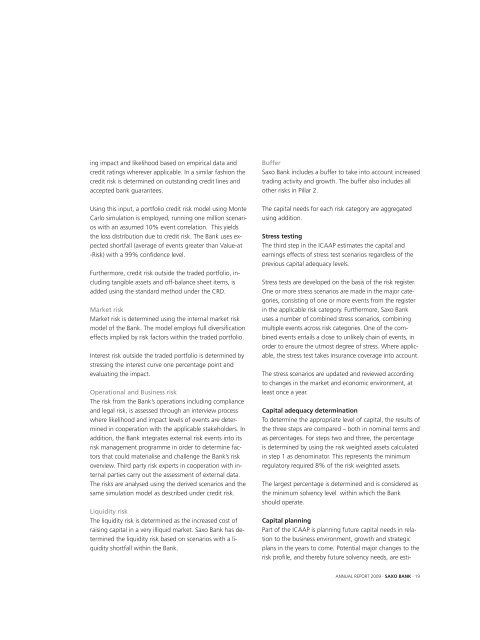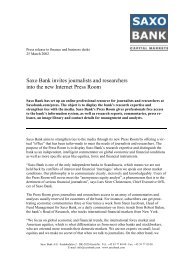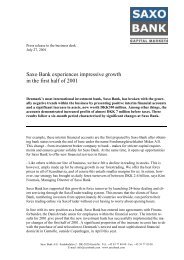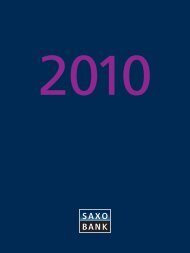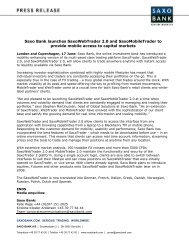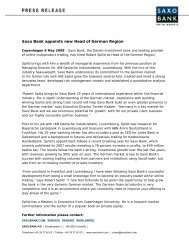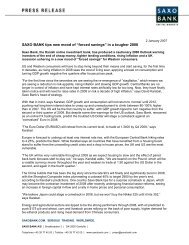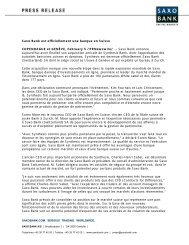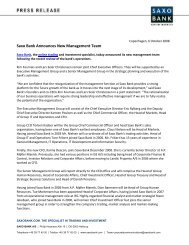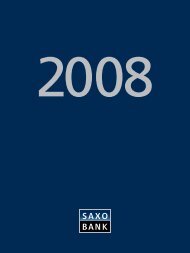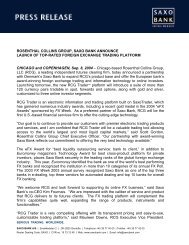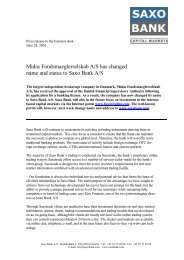Untitled - Saxo World
Untitled - Saxo World
Untitled - Saxo World
You also want an ePaper? Increase the reach of your titles
YUMPU automatically turns print PDFs into web optimized ePapers that Google loves.
ing impact and likelihood based on empirical data andcredit ratings wherever applicable. In a similar fashion thecredit risk is determined on outstanding credit lines andaccepted bank guarantees.Using this input, a portfolio credit risk model using MonteCarlo simulation is employed, running one million scenarioswith an assumed 10% event correlation. This yieldsthe loss distribution due to credit risk. The Bank uses expectedshortfall (average of events greater than Value-at-Risk) with a 99% confidence level.Furthermore, credit risk outside the traded portfolio, includingtangible assets and off-balance sheet items, isadded using the standard method under the CRD.Market riskMarket risk is determined using the internal market riskmodel of the Bank. The model employs full diversificationeffects implied by risk factors within the traded portfolio.Interest risk outside the traded portfolio is determined bystressing the interest curve one percentage point andevaluating the impact.Operational and Business riskThe risk from the Bank’s operations including complianceand legal risk, is assessed through an interview processwhere likelihood and impact levels of events are determinedin cooperation with the applicable stakeholders. Inaddition, the Bank integrates external risk events into itsrisk management programme in order to determine factorsthat could materialise and challenge the Bank’s riskoverview. Third party risk experts in cooperation with internalparties carry out the assessment of external data.The risks are analysed using the derived scenarios and thesame simulation model as described under credit risk.Liquidity riskThe liquidity risk is determined as the increased cost ofraising capital in a very illiquid market. <strong>Saxo</strong> Bank has determinedthe liquidity risk based on scenarios with a liquidityshortfall within the Bank.Buffer<strong>Saxo</strong> Bank includes a buffer to take into account increasedtrading activity and growth. The buffer also includes allother risks in Pillar 2.The capital needs for each risk category are aggregatedusing addition.Stress testingThe third step in the ICAAP estimates the capital andearnings effects of stress test scenarios regardless of theprevious capital adequacy levels.Stress tests are developed on the basis of the risk register.One or more stress scenarios are made in the major categories,consisting of one or more events from the registerin the applicable risk category. Furthermore, <strong>Saxo</strong> Bankuses a number of combined stress scenarios, combiningmultiple events across risk categories. One of the combinedevents entails a close to unlikely chain of events, inorder to ensure the utmost degree of stress. Where applicable,the stress test takes insurance coverage into account.The stress scenarios are updated and reviewed accordingto changes in the market and economic environment, atleast once a year.Capital adequacy determinationTo determine the appropriate level of capital, the results ofthe three steps are compared – both in nominal terms andas percentages. For steps two and three, the percentageis determined by using the risk weighted assets calculatedin step 1 as denominator. This represents the minimumregulatory required 8% of the risk weighted assets.The largest percentage is determined and is considered asthe minimum solvency level within which the Bankshould operate.Capital planningPart of the ICAAP is planning future capital needs in relationto the business environment, growth and strategicplans in the years to come. Potential major changes to therisk profile, and thereby future solvency needs, are esti-ANNUAL REPORT 2009 · SAXO BANK · 19


